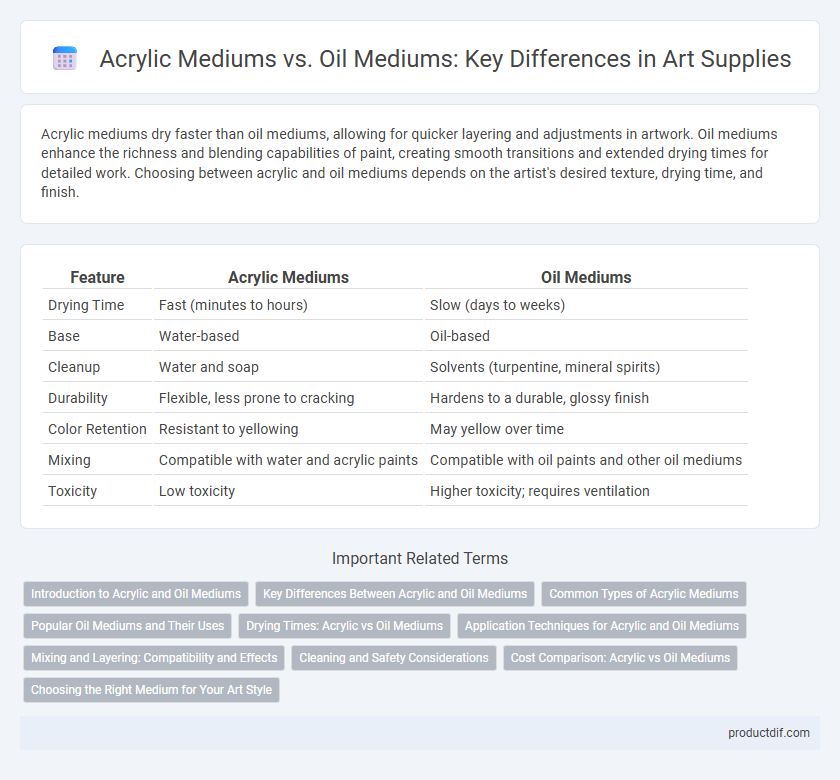Acrylic mediums dry faster than oil mediums, allowing for quicker layering and adjustments in artwork. Oil mediums enhance the richness and blending capabilities of paint, creating smooth transitions and extended drying times for detailed work. Choosing between acrylic and oil mediums depends on the artist's desired texture, drying time, and finish.
Table of Comparison
| Feature | Acrylic Mediums | Oil Mediums |
|---|---|---|
| Drying Time | Fast (minutes to hours) | Slow (days to weeks) |
| Base | Water-based | Oil-based |
| Cleanup | Water and soap | Solvents (turpentine, mineral spirits) |
| Durability | Flexible, less prone to cracking | Hardens to a durable, glossy finish |
| Color Retention | Resistant to yellowing | May yellow over time |
| Mixing | Compatible with water and acrylic paints | Compatible with oil paints and other oil mediums |
| Toxicity | Low toxicity | Higher toxicity; requires ventilation |
Introduction to Acrylic and Oil Mediums
Acrylic mediums are water-based substances that alter the texture, drying time, and finish of acrylic paints, enhancing flexibility and durability. Oil mediums, typically composed of linseed, walnut, or poppy oil, slow drying and increase gloss and transparency in oil paints for richer color blending. Understanding the fundamental differences in drying times, solubility, and finish is essential for artists selecting between acrylic and oil mediums to achieve desired artistic effects.
Key Differences Between Acrylic and Oil Mediums
Acrylic mediums dry faster and are water-based, making them ideal for quick layering and easy cleanup, while oil mediums have a slower drying time and are solvent-based, allowing for more blending and texture manipulation. Acrylic mediums often include retarders, thickeners, and gloss agents that alter drying time and finish, whereas oil mediums such as linseed oil, turpentine, and damar varnish enhance flow, transparency, and durability. The chemical composition of acrylics promotes flexibility and resistance to cracking, contrasting with the traditional richness and depth of color oil mediums provide through their slow oxidation process.
Common Types of Acrylic Mediums
Common types of acrylic mediums include gloss medium, matte medium, and gel medium, each enhancing the paint's texture, finish, and drying time. Gloss medium increases transparency and shine, matte medium reduces reflectivity for a flat finish, and gel medium thickens the paint for impasto effects. These acrylic mediums differ significantly from oil mediums, which typically include linseed oil and walnut oil that extend drying time and alter paint fluidity.
Popular Oil Mediums and Their Uses
Popular oil mediums include linseed oil, which enhances paint flow and gloss while extending drying time, and damar varnish, known for adding a smooth, glossy finish and increasing paint transparency. Stand oil is favored for its thick consistency and ability to create a flexible, durable paint film ideal for glazing techniques. Poppy seed oil is often chosen for its slower drying properties and resistance to yellowing, making it suitable for light colors and delicate layering.
Drying Times: Acrylic vs Oil Mediums
Acrylic mediums dry significantly faster, often within minutes to hours, enabling rapid layering and quicker project completion. In contrast, oil mediums have extended drying times that can span days to weeks, allowing for more blending and refinement but requiring patience. Understanding these drying time differences helps artists select the appropriate medium for their workflow and desired effects.
Application Techniques for Acrylic and Oil Mediums
Acrylic mediums dry quickly and can be layered rapidly, allowing for versatile techniques such as glazing, impasto, and texture creation with gels and pastes. Oil mediums, like linseed oil and liquin, extend drying time and improve flow, enabling smooth blending, wet-on-wet application, and subtle tonal transitions. Mastery of each medium's drying properties enhances control over brushwork and finish in both acrylic and oil painting.
Mixing and Layering: Compatibility and Effects
Acrylic mediums offer fast drying times and excellent compatibility for mixing, allowing for layered techniques without long wait periods, which is ideal for vibrant, textured effects. Oil mediums provide slower drying, enabling seamless blending and rich layering with enhanced luminosity and depth, but require careful consideration of oil-to-medium ratios to prevent cracking. Both mediums support versatile artistic expression, yet their differing drying rates and chemical properties significantly influence mixing behavior and layering outcomes.
Cleaning and Safety Considerations
Acrylic mediums clean easily with water, reducing exposure to harmful solvents, making them safer for indoor use and less toxic overall. Oil mediums require solvents like turpentine or mineral spirits for cleaning brushes and surfaces, increasing the risk of inhaling fumes and contact with skin irritants. Proper ventilation and protective gear are essential when working with oil mediums to minimize health hazards.
Cost Comparison: Acrylic vs Oil Mediums
Acrylic mediums are generally more affordable than oil mediums, making them a cost-effective choice for artists working with limited budgets. Oil mediums tend to be pricier due to the use of natural oils and resins, which also require careful handling and longer drying times. The overall expense of oil painting includes not only the mediums but also additional supplies like solvents, increasing the total investment compared to acrylic painting.
Choosing the Right Medium for Your Art Style
Acrylic mediums dry quickly and offer versatility with effects like glazing, texture building, and increased flow, making them ideal for contemporary and experimental art styles. Oil mediums, such as linseed oil and turpentine, provide longer drying times and richer blending capabilities, perfect for classical, detailed, and layered techniques. Selecting the right medium depends on the desired drying time, finish, and compatibility with your painting process and artistic vision.
Acrylic Mediums vs Oil Mediums Infographic

 productdif.com
productdif.com